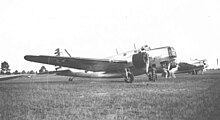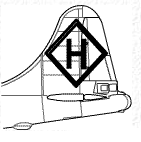|
44th Reconnaissance Squadron
The 44th Reconnaissance Squadron is a unit of the United States Air Force's 432nd Wing, Air Combat Command stationed at Creech Air Force Base, Nevada, where it operates unmanned aerial vehicles. The squadron is assigned to the 432nd Operations Group, and has been reported to operate the Lockheed Martin RQ-170 Sentinel. The first predecessor of the squadron was the 44th Aero Squadron, which was organized in 1917. It served as a training unit until demobilizing in 1919. In 1924, this squadron was consolidated with the 44th Observation Squadron, which conducted aerial reconnaissance for the Field Artillery School. The consolidated squadron was inactivated in 1927. The squadron was again activated in the Panama Canal Zone in 1931. In 1937, it became the 44th Reconnaissance Squadron, recognizing its mission encompassed longer range missions than battlefield observation. Following the attack on Pearl Harbor, the squadron was involved in the defense of the eastern part of the Caribbean. In April 1942, it became the 430th Bombardment Squadron. Later that year, it returned to the United States and became a training and test unit until inactivating in the spring of 1944. It was reactivated a few weeks later as a Boeing B-29 Superfortress unit. It saw combat with the 502d Bombardment Group in the closing months of World War II, flying from Northwest Field, Guam and earning a Distinguished Unit Citation. It remained in the Pacific until it was inactivated on 15 April 1946. HistoryWorld War I The first predecessor of the squadron was established as the 44th Aero Squadron at Camp Kelly, Texas in June 1917, shortly after the United States' entry into World War I. The squadron moved to Wilbur Wright Field, Ohio in August apparently serving as a flying training unit with Standard SJ-1, Curtiss JN-4, and possibly Dayton-Wright DH-4 aircraft. When Air Service training units were reorganized as lettered field squadrons in 1918, the squadron became Squadron K (later Squadron P), Wilbur Wright Field, Ohio. The squadron was demobilized in April 1919.[3] Interwar yearsThe second predecessor of the squadron was organized in June 1922 as the 44th Squadron (Observation) at Post Field, Oklahoma within the Eighth Corps Area, where it flew Dayton-Wright DH-4 and evidently Douglas O-2 aircraft conducting training with the Field Artillery School. The two squadrons were consolidated in 1924, with the consolidated unit retaining the name 44th Observation Squadron. In June 1927, the squadron moved to March Field, California, where it was inactivated at the end of July.[3] The squadron was again activated in the Panama Canal Zone in April 1931. It was initially assigned to the 6th Composite Group, but was assigned or attached to the 16th Pursuit Group from 1932 until 1940.[1] It was the sole reconnaissance unit in the Canal Zone at the time,[citation needed] flying Douglas OA-4 Dolphin amphibians and observation aircraft[1] over both approaches of the canal. The 44th was the first Air Corps unit to occupy Albrook Field after it opened in 1932–33.[citation needed]  Although it retained its Dolphins until 1939, the squadron began to receive medium bomber Martin B-10s in 1936. Acknowledging its concentration on longer range reconnaissance, it was redesignated the 44th Reconnaissance Squadron the following September. On 20 November 1940, the 9th Bombardment Group moved from the United States to the Canal Zoe, and the 44th was attached to it.[1]  The squadron was among the first Canal Zone-based units to equip with the Douglas B-18 Bolo,[citation needed] which joined the unit as early as December 1938. The squadron moved from Albrook to Howard Field in July 1941, ending its nine-year stint at Albrook.[1] There, with five B-18s, one B-18A and the B-17B, the squadron commenced long range reconnaissance training in earnest.[citation needed] The squadron's stay at Howard Field was short lived and the squadron departed for Atkinson Field, British Guiana on 27 October 1941, with the air echelon arriving the following day. The ground echelon sailed on the USAT Franklin S. Leisenring and arrived on 4 November.[1][4] World War IICaribbean defenseFrom British Guiana, the squadron operated as an element of the Trinidad Base Command at Atkinson Field. In late 1941, with the coming of war, the unit commenced far-ranging patrols with its remaining three B-18's and, now, two B-18A's.[citation needed][b] The attachment to the 9th Bombardment Group became an assignment on 25 February 1942,[1] and, by mid-February, following an accident to one of its B-18s and severe maintenance problems with the other aircraft, the squadron could count only one B-18A as airworthy and ready for action.[citation needed] The unit commander also reported that he had "no fully combat trained crews," and, considering that this was the only Air Corps unit at Atkinson at the time, things had deteriorated dangerously.[citation needed] On 22 April 1942, the unit was redesignated the 430th Bombardment Squadron.[1] The squadron continued to fly antisubmarine patrols in the Caribbean until October 1942, when it returned to the United States.[1] This was a move on paper only. The squadron's personnel transferred to the 35th Bombardment Squadron or other units at Atkinson.[4] Test and training unitIn October 1942, the 430th returned to the United States, where it was assigned to the Army Air Forces School of Applied Tactics (AAFSAT) at Orlando Army Air Base, Florida. However, the squadron was not manned until March 1943.[3] The squadron was equipped with Boeing B-17 Flying Fortresses, Consolidated B-24 Liberators, North American B-25 Mitchells, and Martin B-26 Marauders (and a Boeing 247, which had been impressed as the C-73) to train cadres of newly formed bombardment units. It also performed operational testing of new equipment.[5] However, the Army Air Forces (AAF) was finding that standard military units like the 430th, whose manning was based on relatively inflexible tables of organization were proving not well adapted to the training mission. Accordingly, the AAF adopted a more functional system in which each base was organized into a separate numbered unit.[6] The 9th Group and its components moved on paper to Dalhart Army Air Field, Texas on 28 March 1944, and its mission with AAFSAT was assumed by the 906th AAF Base Unit (Bombardment, Heavy) and the 907th AAF Base Unit (Bombardment, Medium and Light).[1][5] B-29 operations and combat The squadron began to reform as a Boeing B-29 Superfortress unit at Dalhart. However, before the squadron could become fully manned and equipped, the AAF reorganized its B-29 units. Although this reorganization increased the number of aircraft assigned to each squadron and to the group, it reduced the number of squadrons in the group from four to three. The squadron was inactivated in this reorganization on 10 May, and its crews and airplanes were distributed to the other three squadrons of the 9th Group.[1][7] A few weeks later, on 1 June 1944, the squadron was activated once again at Davis-Monthan Field as a component of the newly organized 502d Bombardment Group. Five days later, the squadron moved to Dalhart Army Air Field, Texas to begin training with the B-29. The squadron trained at Dalhart and at Grand Island Army Air Field, Nebraska until 7 April 1945, when it departed for the Pacific.[1][8] The squadron arrived at its combat station, Northwest Field, Guam on 12 May 1945. It flew its first combat mission on 30 June, an attack on Rota. It carried out attacks on Truk during July. It flew its first mission against the Japanese Home Islands on 15 July, against the oil refinery at Kudamatsu,[9] and until the end of the war, concentrated on attacks on the Japanese petroleum industry. It was awarded a Distinguished Unit Citation for August 1945 attacks on the coal liquefaction plant at Ube, a tank farm at Amagasaki and the Nippon Oil refinery at Tsuchizaki. After the war it participated in show of force missions and evacuated prisoners of war. The squadron remained on Guam until it was inactivated on 15 April 1946.[1][8] Unmanned vehicle operationsThe squadron returned to its designation of 44th Reconnaissance Squadron when it was activated at Creech Air Force Base, Nevada on 1 April 2015 to fly unmanned aerial vehicles in the reconnaissance role.[1] It has been reported that the unit operates Lockheed Martin RQ-170 Sentinels.[10] Lineage
Assignments
Stations
Aircraft
Awards and campaigns
See alsoReferencesNotes
Bibliography
External links |
||||||||||||||||||||||||||||||||||||||||||||||||||||||||||||||||
Portal di Ensiklopedia Dunia





